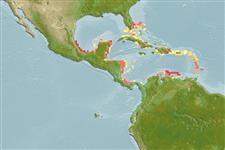Klassifizierung / Names
Namen | Synonyme | Catalog of Fishes(Gattung, Arten) | ITIS | CoL | WoRMS | Cloffa
>
Perciformes/Serranoidei (Groupers) >
Serranidae (Sea basses: groupers and fairy basslets)
Etymology: Hypoplectrus: Greek, hypo = under + Greek, plektron = sting, spur (Ref. 45335); castroaguirrei: Named for Dr. José Luis Castro-Aguirre.
Eponymy: José Luis Castro Aguirre (1943–2011) was a Mexican ichthyologist. [...] (Ref. 128868), visit book page.
Environment: milieu / climate zone / depth range / distribution range
Ökologie
seewasser; tiefenbereich 0 - 3 m (Ref. 90371). Tropical
Western Central Atlantic: SW part of the Veracruz Reef System (VRS), Mexican Gulf.
Size / Gewicht / Alter
Maturity: Lm ? range ? - ? cm
Max length : 9.3 cm SL Männchen/unbestimmt; (Ref. 90371)
Kurzbeschreibung
Bestimmungsschlüssel | Morphologie | Morphometrie
Rückenflossenstacheln (insgesamt) : 10; Rückenflossenweichstrahlen (insgesamt) : 15; Afterflossenstacheln: 3; Afterflossenweichstrahlen: 7. This species is distinguished from its congeners by the its coloration pattern: pale yellow body with a black vertical bar going from the dorsal edge of the head to the edge of the ventral preopercle; triangular black spot at the preopercle and another one that runs along the caudal peduncle; head with iridescent blue vertical lines bordering the eyespot, the contour of the eye socket and the triangular spot; anal, caudal and pelvic fins are bright yellow; pectoral fins are very faint yellow; dorsal fin is pale yellow with oblique positioned blue stripes (Ref. 90371).
Life cycle and mating behavior
Geschlechtsreife | Fortpflanzung | Ablaichen | Eier | Fecundity | Larven
Del Moral Flores, L.F., J.L. Tello-Musi and J.A. Martínez-Pérez, 2012. Descripcíon de una nueva especie del género Hypoplectrus (Actinopterigy: Serrandae) del Sistema Arrecifa Veracruzana, suroeste de Golfo de México. Rev. Zool. 22:1-10. (Ref. 90371)
IUCN Rote Liste Status (Ref. 130435: Version 2024-1)
Bedrohung für Menschen
Harmless
Nutzung durch Menschen
Fischereien: kommerziell
Tools
Zusatzinformationen
Download XML
Internet Quellen
Estimates based on models
Phylogenetic diversity index (Ref.
82804): PD
50 = 0.5000 [Uniqueness, from 0.5 = low to 2.0 = high].
Bayesian length-weight: a=0.01778 (0.00683 - 0.04629), b=3.03 (2.80 - 3.26), in cm total length, based on LWR estimates for this (Sub)family-body shape (Ref.
93245).
Trophic level (Ref.
69278): 3.7 ±0.4 se; based on size and trophs of closest relatives
Fishing Vulnerability (Ref.
59153): Low vulnerability (10 of 100).
